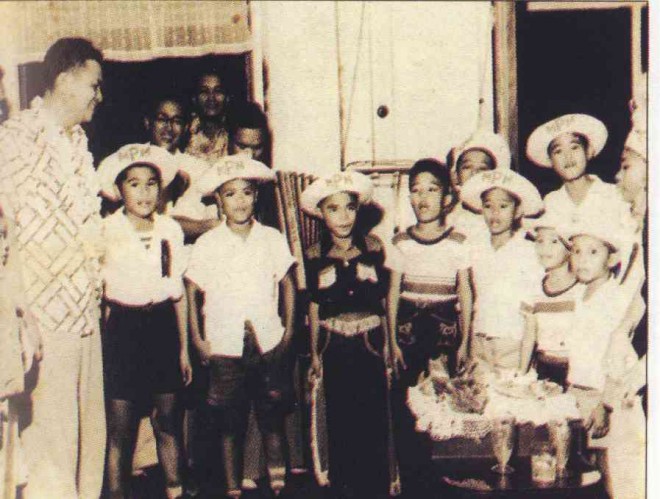Magsaysay, the education Guy
In his very first address to the nation, delivered before a joint session of the Senate and the House of Representatives on Jan. 25, 1954, after his election to the presidency, Ramon Magsaysay (RM) declared that “students have proved their right to participate in public affairs.”
And to underscore this conviction, Magsaysay appointed as his secretary of education Gregorio Hernandez Jr., formerly “a ranking member of the Real Youth Movement (1934-1938)” and “an active crusader for youth participation in public affairs … .”
But the late President, who died in a plane crash on this day 58 years ago, also lamented the “decline of morality” among the youth.
“Character building alone, without a solid moral foundation, has been found inadequate in developing a sound citizenry, ” he said.
Today, various groups hold leadership camps regularly to teach the young, particularly students, the skills and virtues they believe good future leaders should possess, things that Magsaysay’s biographers and other people who had the privilege of knowing him personally said he taught almost single-handedly by his words and deeds.
Article continues after this advertisementJournalist Manuel F. Martinez, who was political affairs undersecretary during the administration of President Corazon C. Aquino, said in his book, “Magsaysay, The People’s President,” that the man Filipinos called “The Guy” popularized the “Credo” or Creed.
Article continues after this advertisementOther politicians also had their own credos that “they could present at the drop of a hat but RM’s was different,” Martinez said.
“Schoolchildren and campus orators and broadcasters and politicians themselves used to recite Magsaysay’s Credo aloud, word for word,” Martinez said.
In his Credo, Magsaysay laid out for the nation what leadership should be.
Dr. Jose Veloso Abueva, former University of the Philippines president and now professor emeritus of Political Science and Public Administration, in his book “Ramon Magsaysay: ‘Servant Leader’ with a Vision of Hope,” said, “More than any Filipino president, Magsaysay exemplified the human model of ‘servant leadership’ because of his values, aims and methods.” The book was the second edition of Abueva’s “Ramon Magsaysay: A Political Biography,” which was published in 1971.
The author said a servant leader, as exemplified by Jesus Christ, led by example, by action, by the quality of his life and possessed qualities like “godliness, integrity, stability, humility, diplomacy, decisiveness, vision, sociability, perceptiveness, and natural common sense.”
Abueva, founder of Kalayaan College, said the late President made people understand what politics and government in a democracy could do to serve and protect them, turning such concepts as “popular sovereignty,” “public office as a public trust,” “the general welfare,” “human dignity” and “social justice” almost real for them. Magsaysay, Abueva said, was the “model of exemplary integrity in public office.”
Despite people’s expectations that his administration would solve all their problems, Magsaysay promoted and encouraged self-help.

DURING the presidential campaign, RM met with some future leaders. PHOTO FROM “RAMON MAGSAYSAY: ‘SERVANT LEADER’ WITH A VISION OF HOPE”
Long before Brigada Eskwela would harness community, private sector and individual initiative and labor to provide for schools’ needs, Magsaysay announced in his second State of the Nation Address (Sona) that government programs in health, education and social welfare were being “reoriented with emphasis on self-help.”
Noting that the “spirit of self-help is sweeping our rural communities,” he said the role of the government was simply to “tap the creative energies of our people and to provide the means by which their desire for improvement can be translated into permanent benefits.”
Magsaysay initiated the use of prefabricated schoolhouses, “mass-produced [and] set up in the barrios, also on a self-help basis, with the people providing the labor,” strengthening the community school movement he started.
While widening opportunities for education by building more schoolhouses, Magsaysay also tried to enhance the chances of employment for the country’s youth by giving emphasis to vocational education, a goal that the recently re-engineered basic education program, K to 12 (kindergarten to Grade 12), is trying to achieve.
Although Magsaysay is remembered more for his success in helping farmers and quelling the peasant rebellion, the President would also take pride in what he had accomplished in the field of education.
In his last Sona on Jan. 28, 1957, Magsaysay said, “The advances made in public education are no less significant. We have continued to give support and encouragement to the education of our youth, particularly in the remote communities. The increase in the number of schools and schoolteachers during the last three years has been considerable. We now have 104,250 teachers, compared with 91,665 three years ago. From 23,600 public schools in 1953, the number has increased to 26,370 in 1956. Our prefabricated school building program has assisted in providing during the last two years additional schoolhouses for the barrios.”
In his Sona, Magsaysay told Congress he would address on a separate occasion “the need to stimulate and foster the growth of our native culture among the youth.”
He started on this route when he became the first Filipino President to wear the barong Tagalog on his inauguration.
Filipinos would never know what other ways he had in mind to make the young appreciate their own culture.
